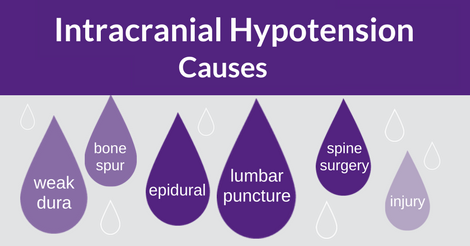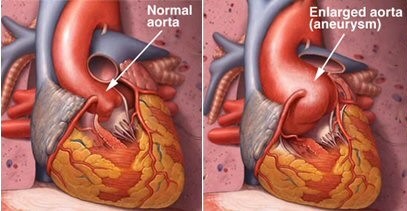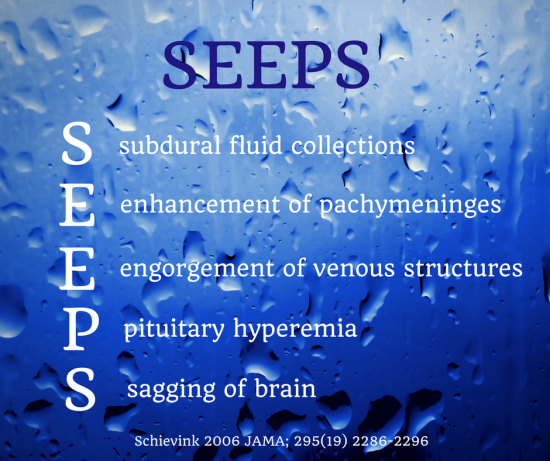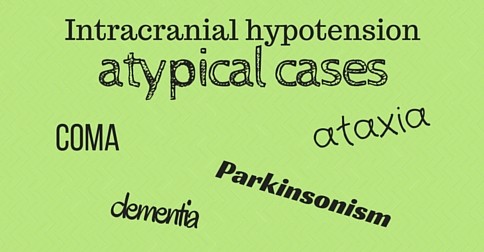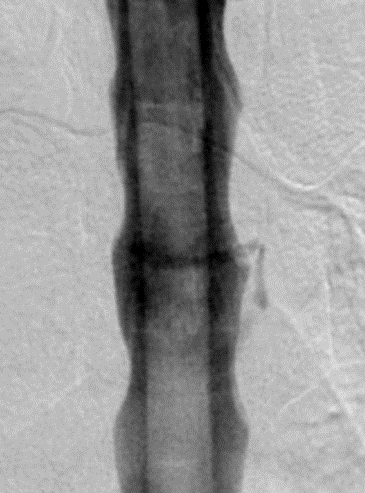There are several situations in which intracranial hypotension (low CSF volume/pressure in the head) can develop. This is almost always secondary to a CSF leak at the level of the spine. There are 3 main categories. Causes of Intracranial Hypotension: 1. Iatrogenic –...
Updates from the Spinal CSF Leak Foundation
Do I Need an Echo?
Many cases of spontaneous intracranial hypotension (SIH) (intracranial hypotension = low pressure inside head) due to spinal CSF (cerebrospinal fluid) leak appear to be related to an underlying weakness of the dura, the connective tissue that holds CSF in around the...
National Organization for Rare Disorders
We have recently joined NORD, the National Organization for Rare Disorders. NORD, a 501(c)(3) organization, is a patient advocacy organization dedicated to individuals with rare diseases and the organizations that serve them. NORD, along with its more than 230 patient...
What is SEEPS?
This clever mnemonic device helps physicians to remember the findings on cranial (brain) MRI imaging in intracranial hypotension (low CSF volume and pressure in the head) from spinal CSF (cerebrospinal fluid) leaks. ALL patients with suspected intracranial hypotension...
Chiari can be “acquired” from spinal CSF leak
We have previously discussed Chiari mimic in the setting of intracranial hypotension secondary to spinal CSF leak. spinalcsfleak.org/mimic-chiari/ Chiari malformation is congenital, but descent of the cerebellar tonsils can be secondary to other disorders, including...
Epidural Patching with Blood + Fibrin Sealant
Physicians at Mayo Rochester have reported on a small series of 8 patients with refractory headache after epidural blood patch. They were then treated with a combination of blood and fibrin glue for epidural patching. Four of eight patients had improved pain scores at...
Atypical and serious cases of intracranial hypotension
This recent paper highlights that the clinical presentation of spontaneous intracranial hypotension secondary to spinal cerebrospinal fluid leak may include serious patterns considered atypical. The authors compared the clinical and imaging findings of 8 atypical...
Digital Subtraction Myelography
A variety of spinal imaging techniques are currently employed in patients with spontaneous intracranial hypotension to localize spinal CSF leaks. Digital subtraction myelography (DSM) is being used increasingly, most often to visualize the origin of rapid leaks. A...
New Online Support Community with Inspire
We are launching Spinal CSF Leak Foundation Support Community in partnership with Inspire. Inspire is a trusted company that builds and manages many online support communities. Our new support community will be a great way for us to offer informational and social...
Spontaneous Spinal CSF Leak – Lori’s Story
After Lori first sought help from a neurologist for her headaches, it took five years before she finally received a proper diagnosis. Lori’s story has features in common with many who suffer with spontaneous spinal cerebrospinal fluid (CSF) leaks. She endured years of...
Spinal CSF Leak – Audrey’s Story
Audrey shares the story of her spinal CSF leak from a labor epidural gone wrong. Can you imagine coming home to your husband and five-year-old son with your newborn son AND a severe headache when upright? Imagine trying to take care of your family when being upright...
Brain descent in intracranial hypotension can mimic Chiari
This is Chiari Awareness Month. What is Chiari malformation? In Chiari malformation, the cerebellar tonsils (part of brain) are displaced downwards below the opening at the base of the skull. Up to 3 mm of descent is considered within normal limits; 3-6 mm of descent...

